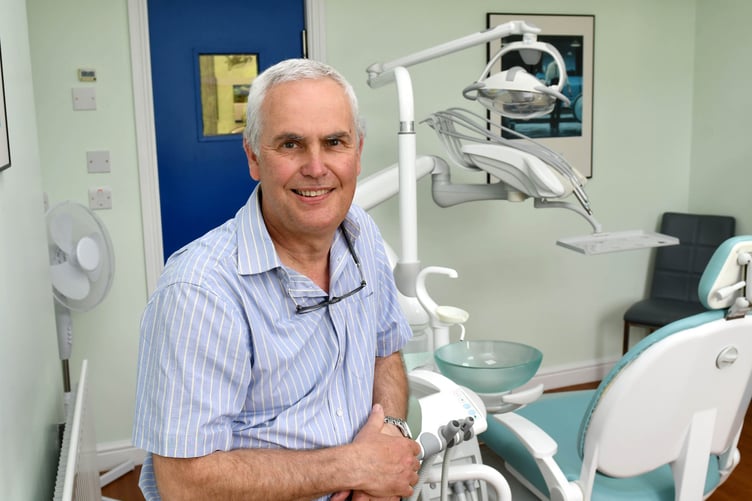Laxey Dental Clinic has been celebrating 20 years in business. Dentist Colin Partington opened the practice in 2002 and since then he has seen many changes in the business of dentistry, including two major milestones when he had to take make or break business decisions.
Colin says: ‘When we started, NHS dentistry was in a state of flux: the old system was called “Fee for Item”, so basically, to make the system work, you had to work very fast and keep your overheads as low as possible and I felt that I couldn’t give the quality of dentistry that I wanted to, so I took the decision that I would only see children on the NHS. I wouldn’t see adults because I just felt that I couldn’t make it work.’
So the practice began on this basis: at first with just Colin and a hygienist and Colin’s wife, Katharine, a trained dental nurse who is the practice manager.
Right from the start Colin put a lot of thought into patient comfort. His premises, which had been Skillicorn’s bathroom showroom had to be completely remodelled, as he recalls: ‘We had a blank canvas here. I didn’t want it to be a typical dentist’s waiting room, I wanted it to be a bit more relaxed, so I went down to the scrapyard, got some old car seats and recovered them.’
It seemed the patients appreciated both the surroundings and the dentistry and Colin was soon recruiting a second dentist.
Then, in 2006, the NHS dropped the Fee for Item payments and went onto a system based on ‘Units of Dental Activity’. This meant that dentists were no longer paid for each item of treatment but for a course of treatments.
Colin explains: ‘This meant that if you did a course of treatment that involved a filling you would get three units of dental activity. If you did a course of treatment that involved 10 fillings you still got three units of dental activity. You did three or you did one, you got paid the same.
‘So, if you are the dentist and you have a patient who needs 10 fillings, the incentive is to say: “You know what? I’m going to do one filling and we’ll just watch the other ones for now”. So NHS dentistry became very profitable if you were prepared to “turn a blind eye”.’
That, however, did not sit well with Colin: ‘I just couldn’t see how I could ethically make it work.’
At that point he decided he could no longer see children on the NHS either and would become a private-only dentist.
He recalls: ‘It was a big decision from my point of view because at that point we thought we were going to lose a lot of patients.
‘You don’t get the pension either so, to make the decision that you’re going to get paid less and lose your pension, what’s the incentive? Well it’s professional pride, I think. I came in to the profession to be a dentist, not to be a businessman and I’m very lucky to have Katharine because she takes care of the vast majority of the business side so that I can fix teeth.’
Katharine says: ‘We wrote individually to our patients and explained why we were doing this and we actually lost just four – and three of them came back.’
Since then Laxey Dental Clinic has been a purely private practice, which is not the moneyspinner you might imagine.
Colin says: ‘Historically, NHS dentistry is more profitable than private dentistry and has been for more than 20 years. But the tide has been changing over the last couple of years, as more and more people go for private dentistry.’
NASDAL, a national organisation in the UK which is made up of specialist dental accountants and lawyers, produces annual benchmarking statistics which compare NHS and private dental practices. Its latest report stated: ‘As we look forward to the 2022 figures, we might expect to see NHS practice profits fall back somewhat and a modest growth in private practice profitability.’
Colin says: ‘Another massive change over the last 20 years is that corporates have got involved – people like My Dentist [Europe’s largest dental care provider with a network of more than 600 practices] and Portman.
‘It seems to be that that’s they way that we’re going because you get economies of scale. If you’re buying the number of gloves we get through, times it by 10 because you’ve got 10 different practices, then they’ve got the buying power. The days of the sole practitioner have gone.’
It’s understandable when you consider just one cost a dental practice has to cover, the cleaning and sterilisation of all the instruments they use.
Cleaning and hygiene was a big issue in dentistry well before the pandemic. In 2013, NHS England brought out a ‘Health Technical Memorandum re Decontamination of primary care dental practices’ which stated that: ‘For best practice, the clinical treatment area should be clearly separate from the decontamination facilities’. In other words, the days of popping instruments into a steriliser in the surgery were over.
Colin and Katharine saw coming and they were ahead of the game in devising a system that works well.
This has meant turning a room in the building’s basement into a dedicated cleaning and sterilising facility and installing a service lift to take the used instruments down there – on a shelf marked ‘Dirty’ – and bring the clean ones back up.
The cleaning process involves them being washed and rinsed, then inspected under magnification to ensure they are perfectly clean, before they go into the autoclaves for sterilising.
As the instruments travel around the room being processed their route is clearly marked in a one way system on the floor so that they move from dirty to clean seamlessly without crossing the same path.
Once cleaned and sterilised they are packed and wrapped in different coloured boxes, to indicate their cleanliness and which dentist they belong to, and are placed on the ‘Clean’ shelf in the lift, to travel back up to the surgeries.
The new system has also meant buying a lot more instruments but Colin is pleased with the final result. He says: ‘It flows and it does work well.’
He has also bought a CT scanner because he is now doing a lot of implant work and the scans help him plan each implant job.
The practice now numbers 15 staff including two other dentists, Neil Gibb who arrived in 2008 and Richard Wild who joined in 2020, two hygienists and dental nurses.
Colin has clearly benefited from taking his business decisions based, not on profitability, but rather on care for his patients and job satisfaction.
He says: ‘I came into dentistry to be a dentist, not to make lots of money.
‘It’s a necessary evil, to make sure that the income is more than the outgoings, otherwise I can’t do my job but beyond that it wasn’t my motivation.
‘I’m 63 now and I would like to carry on working as long as I am enjoying it.
‘And I am enjoying it.’

.png?width=209&height=140&crop=209:145,smart&quality=75)


.png?width=209&height=140&crop=209:145,smart&quality=75)
Comments
This article has no comments yet. Be the first to leave a comment.